- PrivaceraCloud Release 7.4
- Enhancements and updates in PrivaceraCloud release 7.4
- Known Issues in PrivaceraCloud 7.4
- PrivaceraCloud User Guide
- Overview of PrivaceraCloud
- Connect applications with the setup wizard
- Connect applications
- About applications
- Connect Azure Data Lake Storage Gen 2 (ADLS) to PrivaceraCloud
- Connect Amazon Textract to PrivaceraCloud
- Athena
- Privacera Discovery with Cassandra
- Connect Databricks to PrivaceraCloud
- Databricks SQL
- Databricks SQL Overview and Configuration
- Planning and general process
- Prerequisites
- Databricks SQL with Privacera Hive
- Connect Databricks SQL application
- Grant Databricks SQL permissions to PrivaceraCloud users
- Define a resource policy
- Test the policy
- Databricks SQL PolicySync fields
- Configuring column-level access control
- View-based masking functions and row-level filtering
- Create an endpoint in Databricks SQL
- Databricks SQL Fields
- Databricks SQL Hive Service Definition
- Databricks SQL Masking Functions
- Databricks SQL Encryption
- Use a custom policy repository with Databricks
- Connect Databricks SQL to Hive policy repository on PrivaceraCloud
- Databricks SQL Overview and Configuration
- Connect Databricks Unity Catalog to PrivaceraCloud
- Connect S3 to PrivaceraCloud
- Prerequisites in AWS console
- Connect S3 application to PrivaceraCloud
- Enable Privacera Access Management for S3
- Enable Data Discovery for S3
- S3 AWS Commands - Ranger Permission Mapping
- S3
- AWS Access with IAM
- Access AWS S3 buckets from multiple AWS accounts
- Add UserInfo in S3 Requests sent via Dataserver
- Control access to S3 buckets with AWS Lambda function on PrivaceraCloud
- Dremio Plugin
- DynamoDB
- Connect Elastic MapReduce from Amazon application to PrivaceraCloud
- Connect EMR application
- EMR Spark access control types
- PrivaceraCloud configuration
- AWS IAM roles using CloudFormation setup
- Create a security configuration
- Create EMR cluster
- How to configure multiple JSON Web Tokens (JWTs) for EMR
- EMR Native Ranger Integration with PrivaceraCloud
- Connect EMRFS S3 to PrivaceraCloud
- Files
- GBQ
- Google Cloud Storage
- Connect Glue to PrivaceraCloud
- Google BigQuery for PolicySync
- Connect Kinesis to PrivaceraCloud
- Connect Lambda to PrivaceraCloud
- Microsoft SQL Server
- MySQL for Discovery
- Open Source Apache Spark
- Oracle for Discovery
- PostgreSQL
- Connect Power BI to PrivaceraCloud
- Presto
- Redshift
- Snowflake
- Starburst Enterprise with PrivaceraCloud
- Starburst Enterprise Presto
- Trino
- Connect users
- Data access Users, Groups, and Roles
- UserSync
- Portal user LDAP/AD
- Datasource
- Okta Setup for SAML-SSO
- Azure AD setup
- SCIM Server User-Provisioning
- User Management
- Identity
- Access Manager
- Access Manager
- Resource Policies
- Tag Policies
- Scheme Policies
- Service Explorer
- Reports
- Audit
- About data access users, groups, and roles resource policies
- Security zones
- Discovery
- Classifications via random sampling
- Privacera Discovery scan targets
- Propagate Privacera Discovery Tags to Ranger
- Enable offline scanning on Azure Data Lake Storage Gen 2 (ADLS)
- Enable Real-time Scanning of S3 Buckets
- Enable Real-time Scanning on Azure Data Lake Storage Gen 2 (ADLS)
- Enable Discovery Realtime Scanning Using IAM Role
- Encryption
- Overview of Privacera Encryption
- Encryption schemes
- Presentation schemes
- Masking schemes
- Create scheme policies
- Privacera-supplied encryption schemes for the Privacera API
- Privacera-supplied encryption schemes for the Bouncy Castle API
- API date input formats
- Deprecated encryption formats, algorithms, and scopes
- Privacera Encryption REST API
- PEG API endpoint
- PEG REST API encryption endpoints
- Prerequisites
- Common PEG REST API fields
- Construct the datalist for the /protect endpoint
- Deconstruct the response from the /unprotect endpoint
- Example data transformation with the /unprotect endpoint and presentation scheme
- Example PEG API endpoints
- Make encryption API calls on behalf of another user
- Privacera Encryption UDF for masking in Databricks on PrivaceraCloud
- Privacera Encryption UDFs for Trino on PrivaceraCloud
- Syntax of Privacera Encryption UDFs for Trino
- Prerequisites for installing Privacera Crypto plug-in for Trino
- Download and install Privacera Crypto jar
- Set variables in Trino etc/crypto.properties
- Restart Trino to register the Privacera encryption and masking UDFs for Trino
- Example queries to verify Privacera-supplied UDFs
- Privacera Encryption UDF for masking in Trino on PrivaceraCloud
- Encryption UDFs for Apache Spark on PrivaceraCloud
- Launch Pad
- Settings
- Dashboard
- Usage statistics
- Operational status of PrivaceraCloud and RSS feed
- How to Get Support
- Coordinated Vulnerability Disclosure (CVD) Program of Privacera
- Shared Security Model
- PrivaceraCloud Previews
- Preview: File Explorer for S3
- Preview: File Explorer for Azure
- Preview: File Explorer for GCS
- Preview: Scan Generic Records with NER Model
- Preview: Scan Electronic Health Records with NER Model
- Preview: OneLogin setup for SAML-SSO
- Preview: Azure Active Directory SCIM Server UserSync
- Preview: OneLogin UserSync
- Preview: PingFederate UserSync
- Quickstart for Databricks Unity Catalog on PrivaceraCloud
- What do I need to do in my Databricks Workspace?
- Where is the sample dataset in my Databricks Workspace?
- What should I do in the PrivaceraCloud web portal?
- Access use-case - How do I give a user access to a table or restrict from running a SQL select query?
- Access use-case - How do I restrict a user from seeing contents of a column in the result of a SQL select query?
- Column masking use-case - How do I restrict a user from seeing contents of a column by masking the values in the result of a SQL select query?
- Access use-case - How do I disallow a user from seeing certain rows of a table?
- PrivaceraCloud documentation changelog
PrevNext
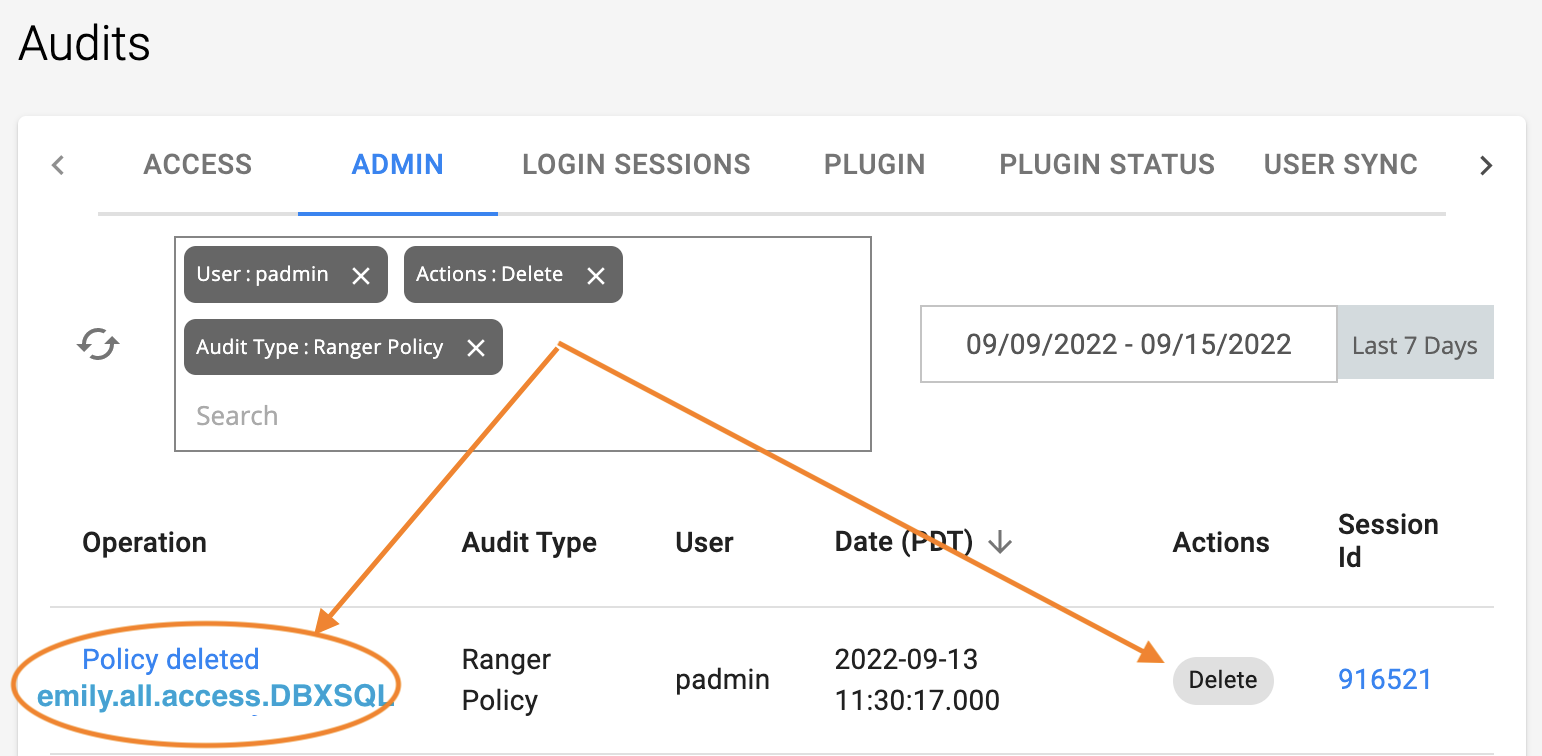
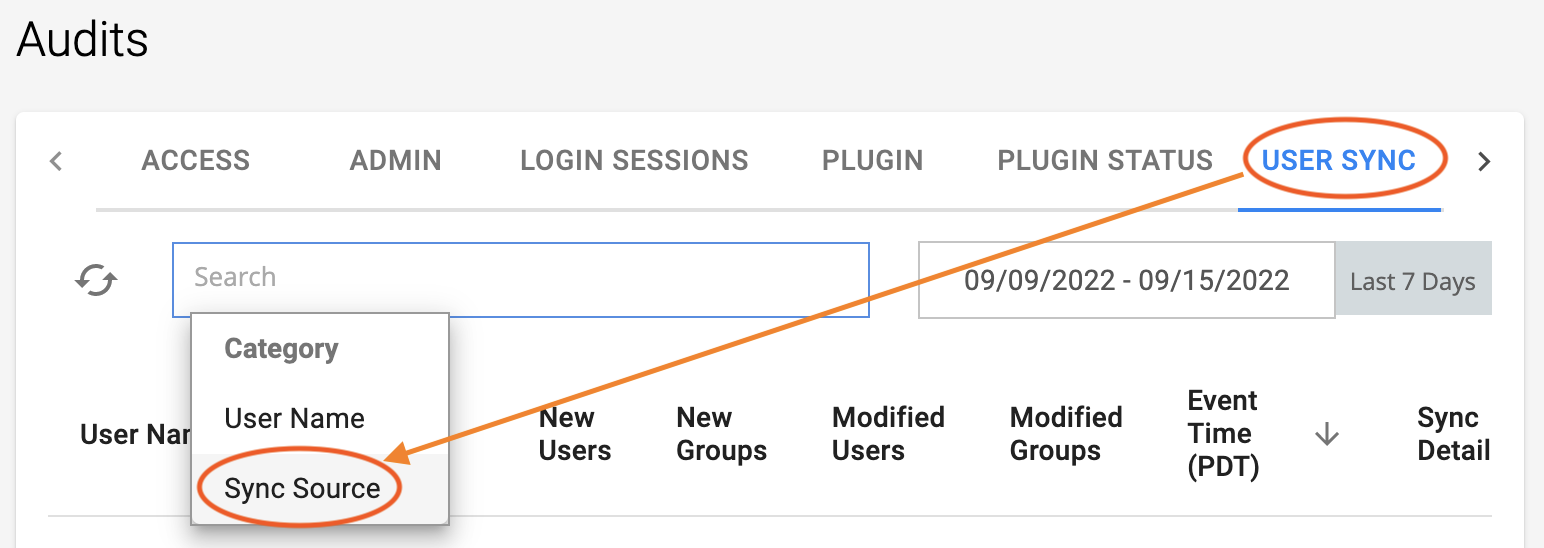
Examples of audit search
:
These examples show using Search on the Audits page to find records of various kinds.
As you position your cursor in the Search box, the system guides you through refining your search. You can pick from various displayed menus as you refine.
Find policies deleted by an administrator
Click the ADMIN tab, and in the Search box, select User. This example shows the default administrative user padmin.
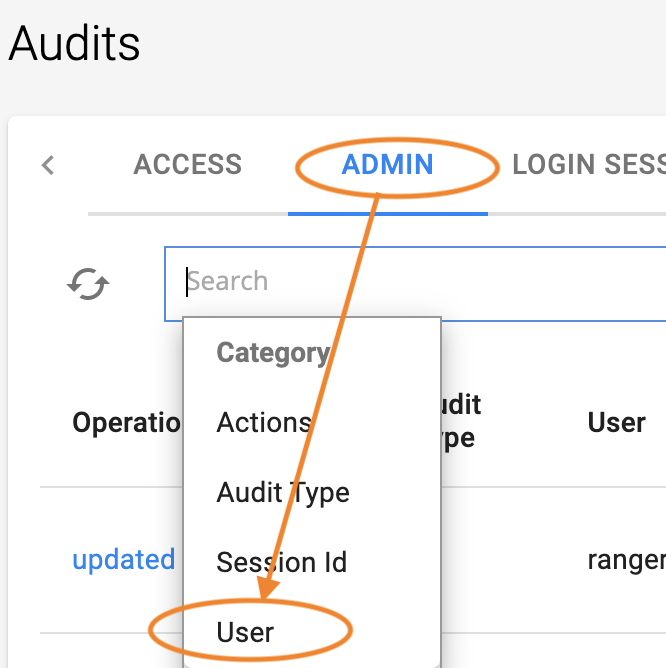 |
For Actions, specify Delete.
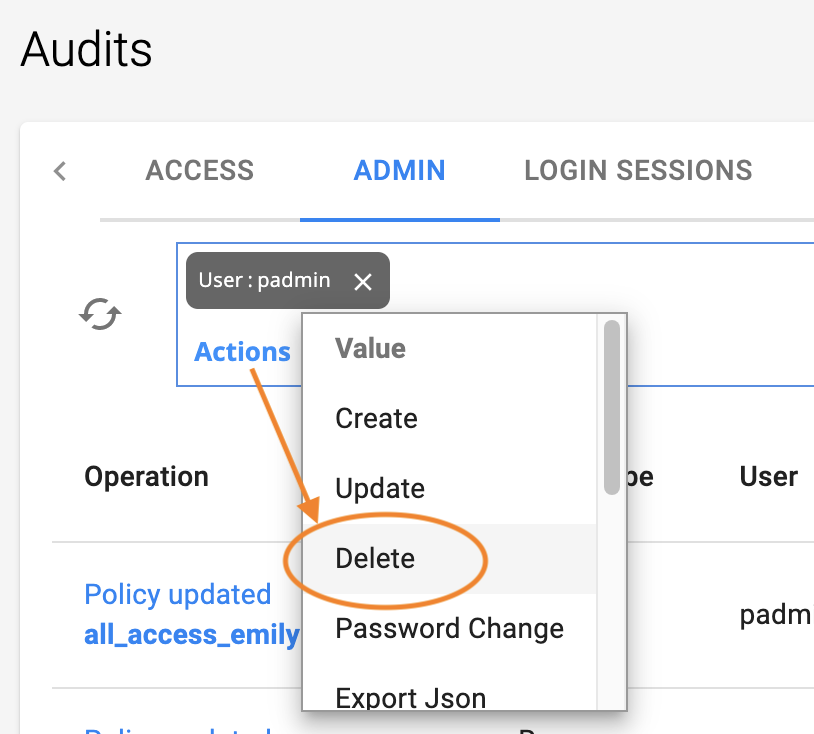 |
For Category, select Audit Type.
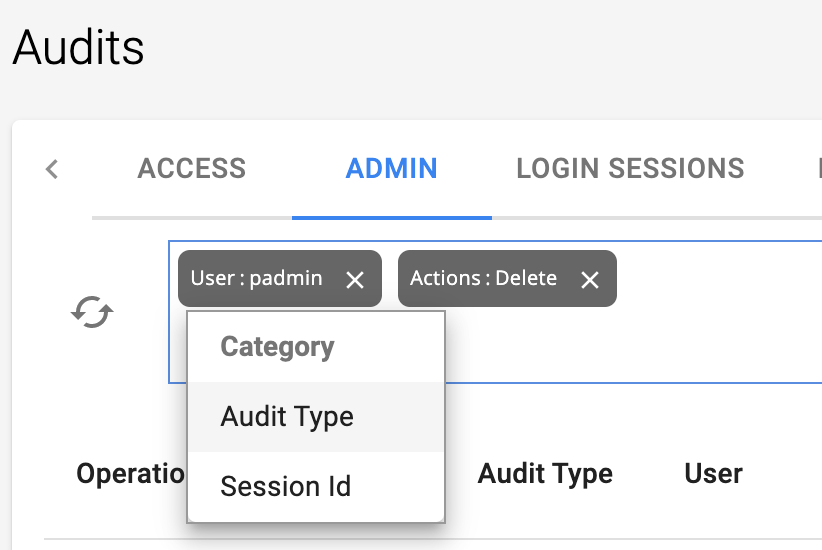 |
For Audit Type, select Ranger Policy.
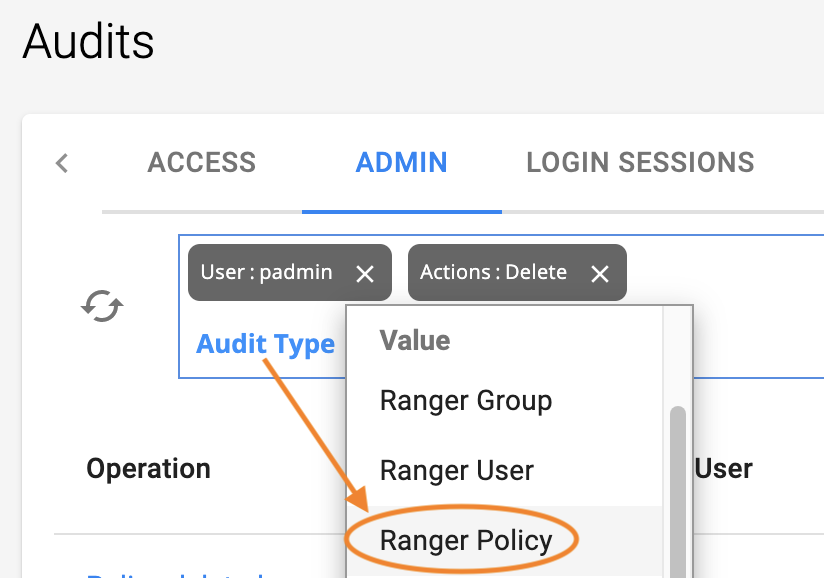 |
The results are displayed.

Find statistics of a UserSync from LDAP
Click the USER SYNC tab, and in the Search box, for Category, select Sync Source.

For Sync Source, select LDAP/AD.
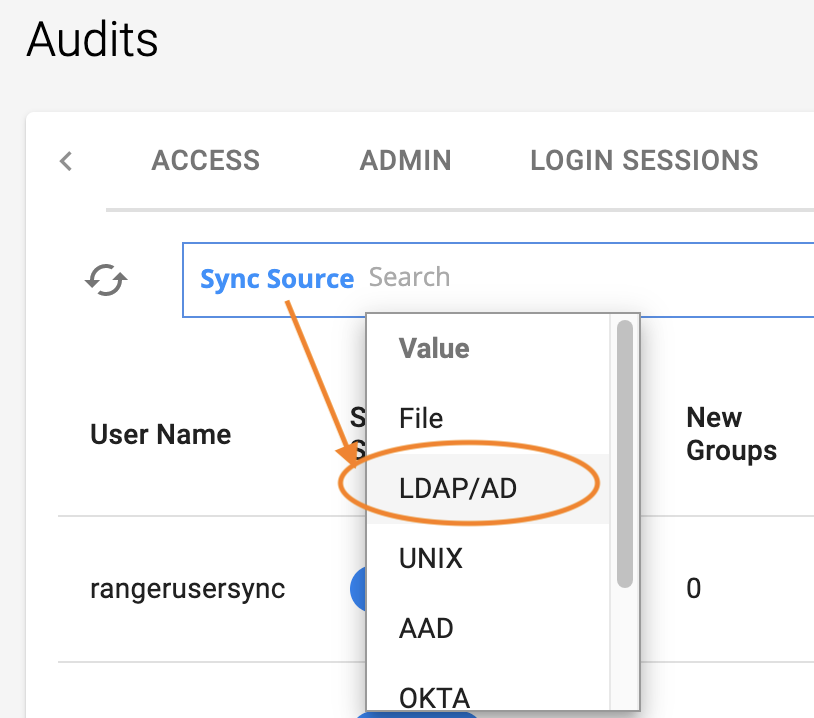 |
The results are displayed. For details about a record, click the eye on the far right.
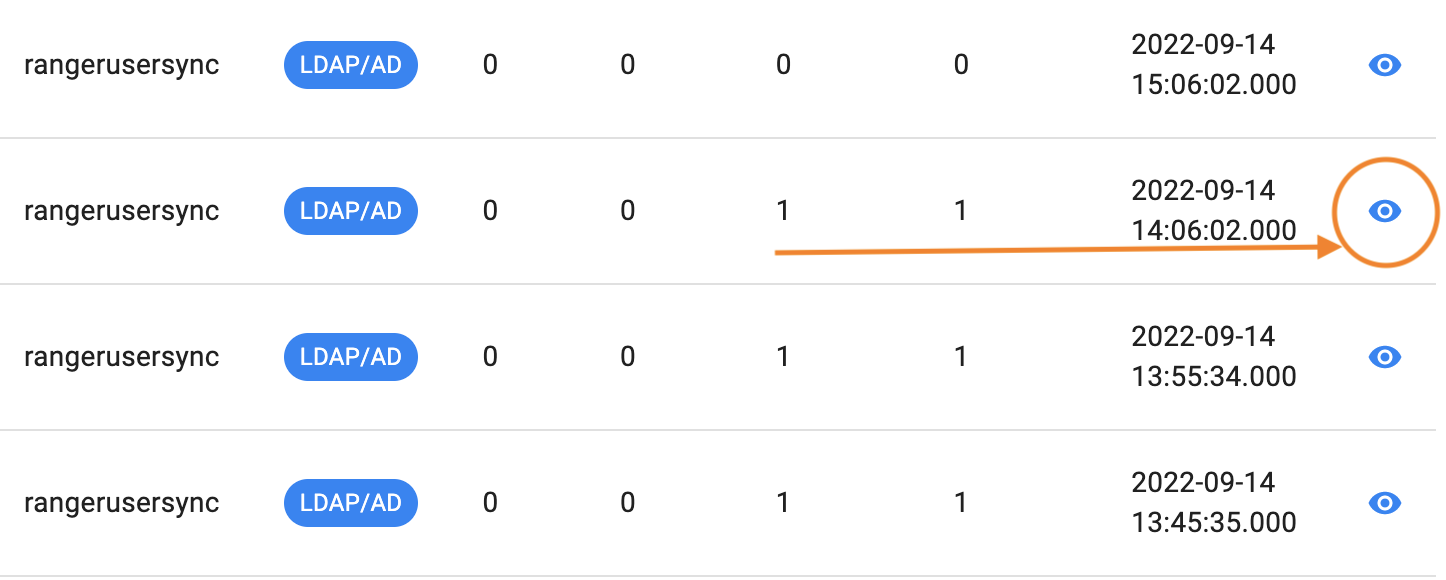 |
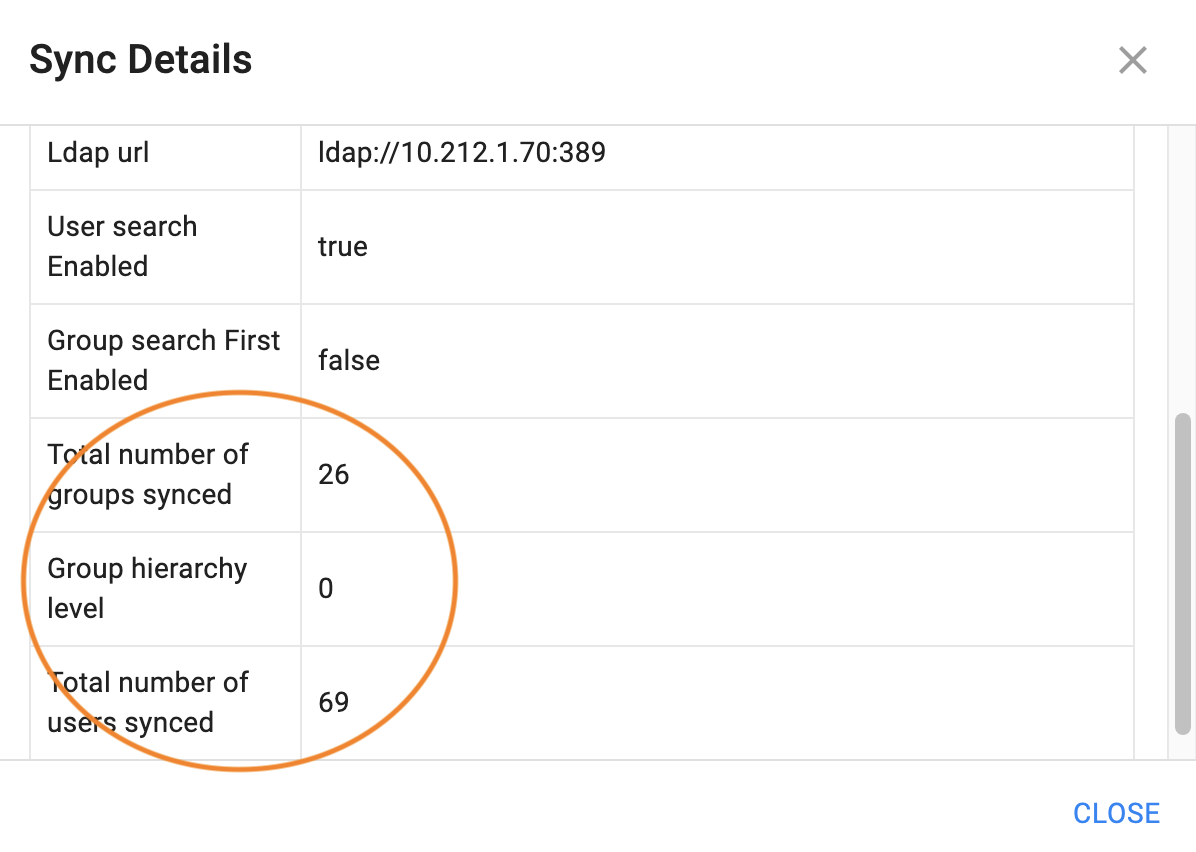 |
